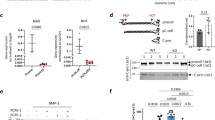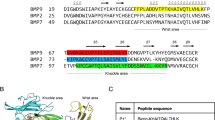Abstract
The term 'platelet-derived growth factor' (PDGF) refers to a family of disulphide-bonded dimeric isoforms that are important for growth, survival and function in several types of connective tissue cell. So far, three different PDGF chains have been identified — the classical PDGF-A and PDGF-B1,2 and the recently identified PDGF-C3. PDGF isoforms (PDGF-AA, AB, BB and CC) exert their cellular effects by differential binding to two receptor tyrosine kinases. The PDGF α-receptor (PDGFR-α) binds to all three PDGF chains, whereas the β-receptor (PDGFR-β) binds only to PDGF-B1. Gene-targeting studies using mice have shown that the genes for PDGF-A and PDGF-B, as well as the two PDGFR genes, are essential for normal development4. Furthermore, overexpression of PDGFs is linked to different pathological conditions, including malignancies, atherosclerosis and fibroproliferative diseases1. Here we have identify and characterize a fourth member of the PDGF family, PDGF-D. PDGF-D has a two-domain structure similar to PDGF-C3 and is secreted as a disulphide-linked homodimer, PDGF-DD. Upon limited proteolysis, PDGF-DD is activated and becomes a specific agonistic ligand for PDGFR-β . PDGF-DD is the first known PDGFR-β-specific ligand, and its unique receptor specificity indicates that it may be important for development and pathophysiology in several organs.
This is a preview of subscription content, access via your institution
Access options
Subscribe to this journal
Receive 12 print issues and online access
$209.00 per year
only $17.42 per issue
Buy this article
- Purchase on Springer Link
- Instant access to full article PDF
Prices may be subject to local taxes which are calculated during checkout



Similar content being viewed by others
References
Heldin, C. H. & Westermark, B. Physiol. Rev. 79, 1283–1316 (1999).
Raines, E. W., Bowen-Pope, D. F. & Ross, R. in Handbook of Experimental Pharmacology: Peptide Growth Factors and Their Receptors I (eds Sporn, M. B. & Roberts, A. B.) 173–262 (Springer, New York, 1990).
Li, X. et al. Nature Cell Biol. 2, 302–309 (2000).
Lindahl, P. et al. Curr. Top. Pathol. 93, 27–33 (1999).
Bork, P. & Beckmann, G. J. Mol. Biol. 231, 539–545 (1993).
Subramaniam, A. et al. J. Biol. Chem. 266, 24613–24620 (1991).
Lindahl, P. et al. Development 125, 3313–3322 (1998).
Arar, M. et al. J. Biol. Chem. 275, 9527–9533 (2000).
Levéen, P. et al. Genes Dev. 8, 1875–1887 (1994).
Soriano, P. Genes Dev. 8, 1888–1896 (1994).
LaRochelle, W. J. et al. Nature Cell Biol. 3, 517–521 (2001).
Kunkel, T. A., Roberts, J. D. & Zakour, R. A. Methods Enzymol. 154, 367–382 (1987).
Vieira, J. & Messing, J. Methods Enzymol. 153, 3–11 (1987).
Heldin, C-H. et al. EMBO J. 7, 1387–1393 (1988).
Eriksson, A., Siegbahn, A., Westermark, B., Heldin, C-H. & Claesson-Welsh, L. EMBO J. 11, 543–550 (1992).
Aase, K. et al. Dev. Dynam. 215, 12–25 (1999).
Acknowledgements
We thank B. Åkerblom, C. Raynoschek, T. Tainola and G. Bäckström for technical assistance, U. Engström for synthesizing peptides, M. Hansson for help with production of recombinant proteins, A. Pontén and K. Aase for discussions, and C. Betsholtz for comments on the manuscript. This work was supported by grants from the Swedish Cancer Society, the Swedish Medical Research Council, the Finnish Academy of Sciences and the Novo Nordisk Foundation.
Author information
Authors and Affiliations
Corresponding author
Rights and permissions
About this article
Cite this article
Bergsten, E., Uutela, M., Li, X. et al. PDGF-D is a specific, protease-activated ligand for the PDGF β-receptor. Nat Cell Biol 3, 512–516 (2001). https://doi.org/10.1038/35074588
Received:
Revised:
Accepted:
Published:
Issue Date:
DOI: https://doi.org/10.1038/35074588
This article is cited by
-
Endothelial progenitor cells overexpressing platelet derived growth factor-D facilitate deep vein thrombosis resolution
Journal of Thrombosis and Thrombolysis (2022)
-
Understanding angiogenesis and the role of angiogenic growth factors in the vascularisation of engineered tissues
Molecular Biology Reports (2021)
-
Conditional deletion of platelet derived growth factor receptor alpha (Pdgfra) in urorectal mesenchyme causes mesenchyme apoptosis and urorectal developmental anomalies in mice
Cell Death & Differentiation (2019)
-
Neovascular glaucoma regulation by arylsulfonyl indoline-benzamide (ASIB) through targeting NF-kB signalling pathway
3 Biotech (2019)
-
Platelet-Derived Growth Factor Receptor-α and β are Involved in Fluid Shear Stress Regulated Cell Migration in Human Periodontal Ligament Cells
Cellular and Molecular Bioengineering (2019)



